- Home
- |
- Our Culture
- Louis Riel
- Métis Firsts in North America
- Métis Minute
- Who are we?
- Métis Nation Database
- Kids' Corner
- I Love to Bead Month
- |
- Departments / Affiliates
- Citizenship
- Culture & Heritage
- Early Learning & Child Care
- Economic Development
- Engagement and Consultation
- Energy, Infrastructure & Resource Management
- Health & Wellness
- Housing and Property Management
- Infinity Women Secretariat
- Louis Riel Capital Corporation
- Louis Riel College
- Louis Riel Institute
- MEDOCare
- Métis Child and Family Services Authority
- Métis Employment & Training
- Métis Justice Institute
- Métis Rights & Constitution
- Michif Language
- Provincial Education
- Red River Métis Business Development Corporation
- Red River Métis Community Resource
- Red River Métis Fur Company
- Red River Métis Veterans
- Riel House
- Sixties Scoop
- Youth
- |
- Government
- |
- Jobs
- |
- News
- |
- Contact
Michelle Pichette
October 10, 2021
Honouring Ancestors through mukluk beadwork
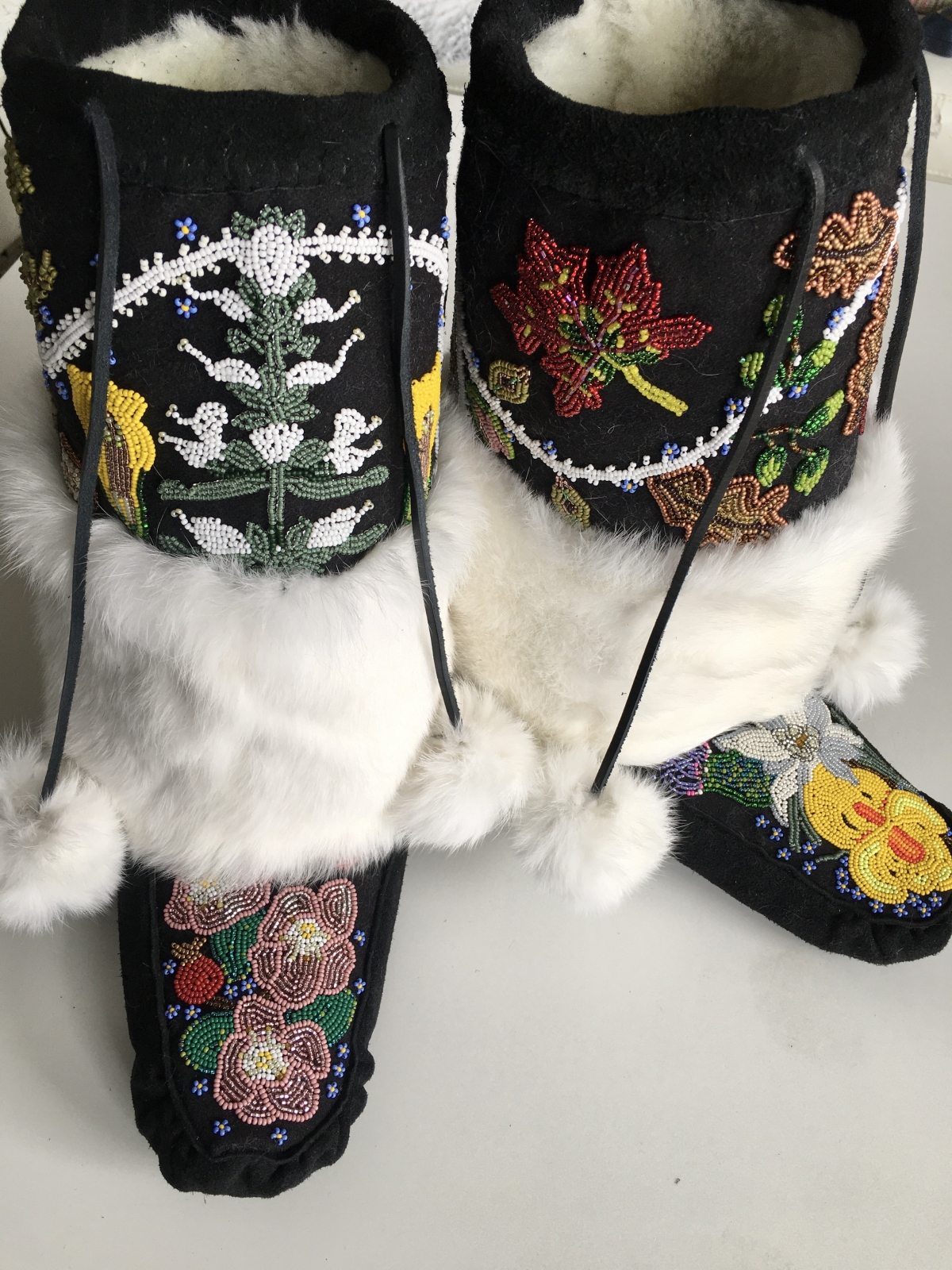
The pair of mukluks, titled "Where They Walked," were made to honour Pichette's paternal Indigenous female Ancestors.
The mukluks include botanical imagery based on the areas Pichette's Ancestors would have lived and travelled over time.
Michelle Pichette has been a maker for as long as she can remember.
When she was around the age of 10, she received a McCall's Make-It Book from a neighbour, and made everything in the large book.
"They were all simple things from scraps around the house - paper dolls, string art, paper baskets, and games made out of thread spools, and things like that," Pichette said.
The following year, when her great-aunt saw a Donald Duck drawing she had copied from a book, she enrolled her in painting lessons for the next four years.
"After that, I got a bursary from the WAG (Winnipeg Art Gallery) Women's Committee when I was about 15 for supplies and painting lessons, and there I also had my first introduction to making things with clay," she said.
Later on in life, after she got married and had kids, Pichette spent years making handmade tiles - a hobby that turned into a small studio business.
"It got to the point that I was making things because they 'sold,' and (it) started to feel more stagnated artistically. And I also was spending more time administratively than actually making art," she said. "I decided I wanted to push the intellectual and creative aspect of the artwork further versus production work."
While Pichette had always wanted to get her art degree, she was not previously able to afford it. When her kids were in school and she was in her 40s, she finally got the courage to apply to the University of Manitoba for her Bachelor of Fine Arts.
"I majored in print making, but I enjoyed the installation-based work the most, but at that time that was not an option for a major area," Pichette said.
By the time she graduated in 2007, she received a gold medal for highest standing in the Studio Program.
Shortly after graduation, Pichette became quite ill, which greatly affected her productivity.
"Learning to come to terms with chronic illness has been a very long, hard process, and it's only recently that I've started to do things more creatively again," she said.
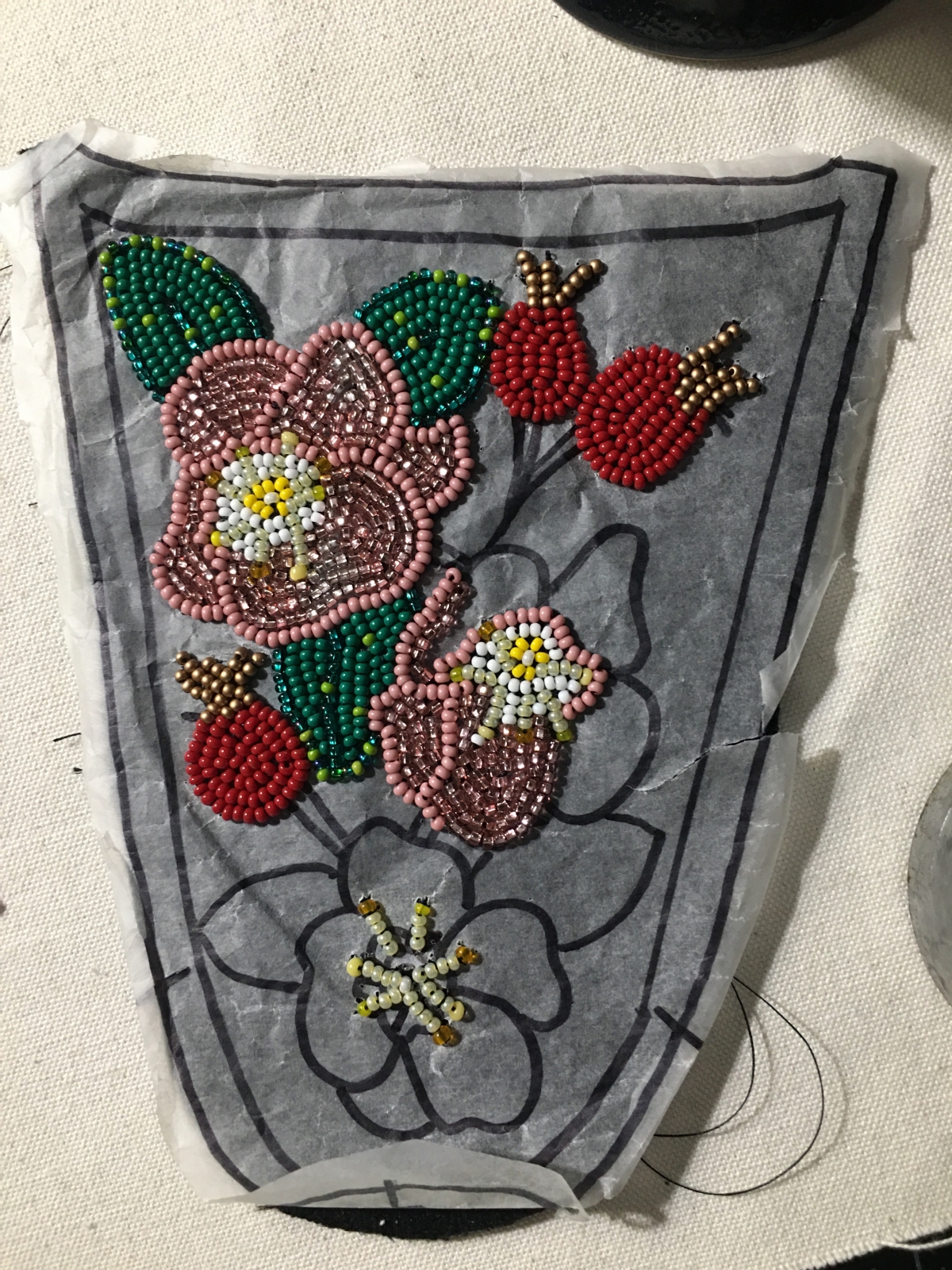
Pichette said assembling the mukluks was surprisingly easy, while the beading was the most gratifying and time-consuming.
Branching out
Pichette has had the ability to work in various mediums, and in spring 2021, she decided to diversify even further to make a pair of mukluks.
While she is primarily self-taught, Pichette picked beadwork up quickly. She attended an online beading circle organized by Mentoring Artists for Women's Art (MAWA), which included a two-hour beaded earring class and a stuffed strawberry class.
"I joined it and mostly just watched and listened," she said, "and asked probably far too many questions."
Pichette also watched online videos on one- and two-needle beading - both methods she used to make the mukluks.
"I don't know why, but it just came naturally, and I count my blessings that I am fortunate that way," she said.
"I had no clue whatsoever how to make them, what materials I would need, or how much material, so I started looking online to figure it out, and I came across a site where somebody was offering basically a 'kit' with materials and a pattern to make specifically a mukluk."
Pichette applied for a MAWA COVID maker grant, which made the purchase of the supplies possible.
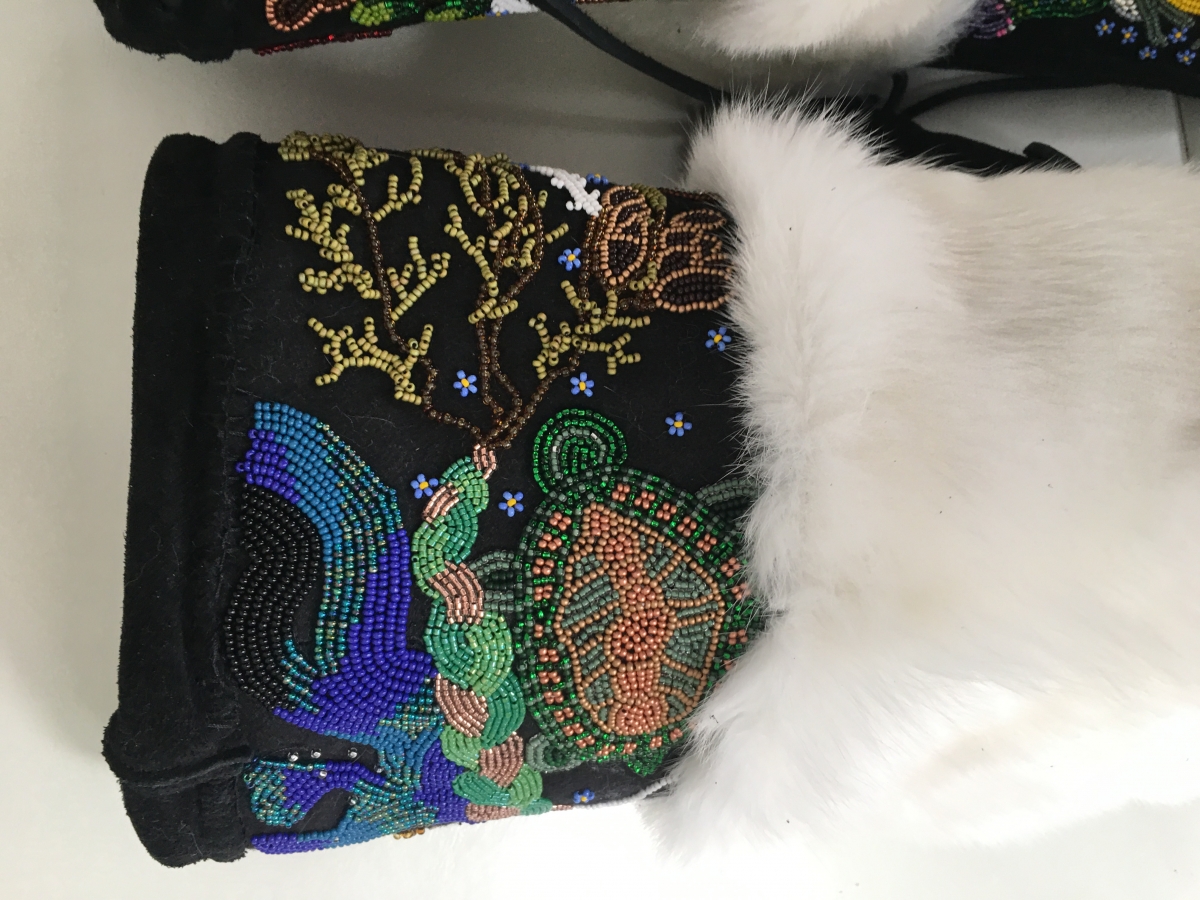
The mukluks are made of leather, rabbit fur, wool, canvas, thread, and size 10 and 12 beads.
She found that the demand of making the mukluks was manageable while living with her chronic illness.
"My health issues are a roller coaster of energy levels, and being able to do something that you can easily come and go from was really a blessing, unlike clay work, which you have to be on top (of) all the time," she said.
"The beading was a very slow process, which actually was something that I needed," she said, adding that creating this work gave her a much-needed sense of purpose.
Pichette said assembling the mukluks was surprisingly easy, while the beading was the most gratifying and time-consuming.
"The beading decisions were made as I went along, in regard to selecting colours, sizes, and the different cuts of the beads," she said. "For each element, I just laid down one colour of bead and decided what I thought would go best next to it. Some worked really well and others I would do different next time."
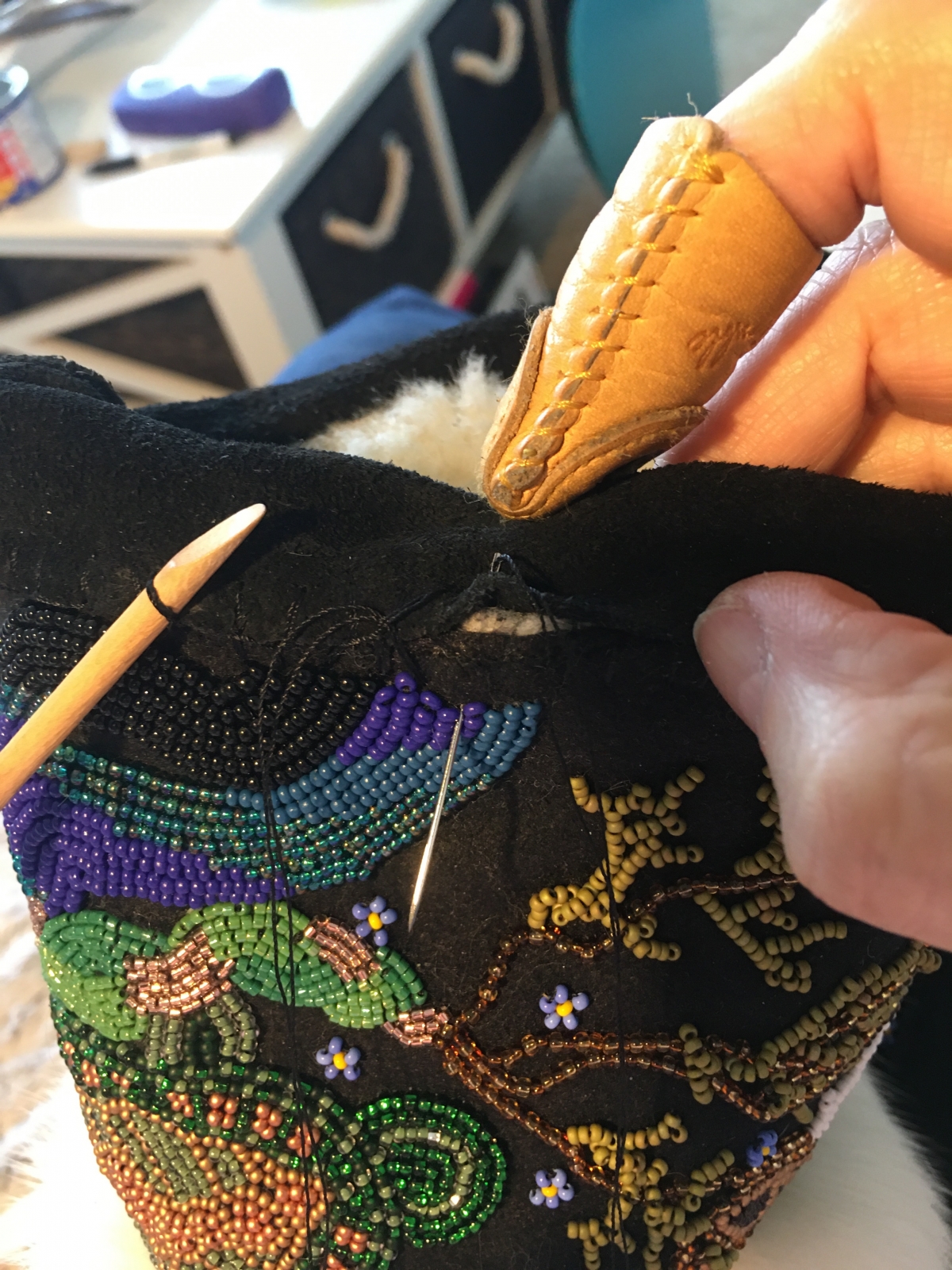
Pichette found that the demand of making the mukluks was manageable while living with her chronic illness.
"Where They Walked"
The pair of mukluks, titled "Where They Walked," were made to honour Pichette's paternal Indigenous female Ancestors. Made of leather, rabbit fur, wool, canvas, thread, and size 10 and 12 beads, the mukluks include botanical imagery based on the areas Pichette's Ancestors would have lived and travelled over time.
"I got a great big map, and when I started seeing all the different places, I thought, 'OK, I have to map this, I have to know where they were, and where they went, and how they got there. So, I saw that they moved south, then west, and then north, and then west, and I imagined how many footsteps they walked across that land," she said.
"I imagined the plants and surroundings they had to utilize for survival. I thought about what I could do best to honour their journey to me, to this place, to this time. Footwear would have been imperative for such treks and winter wear definitely needed.
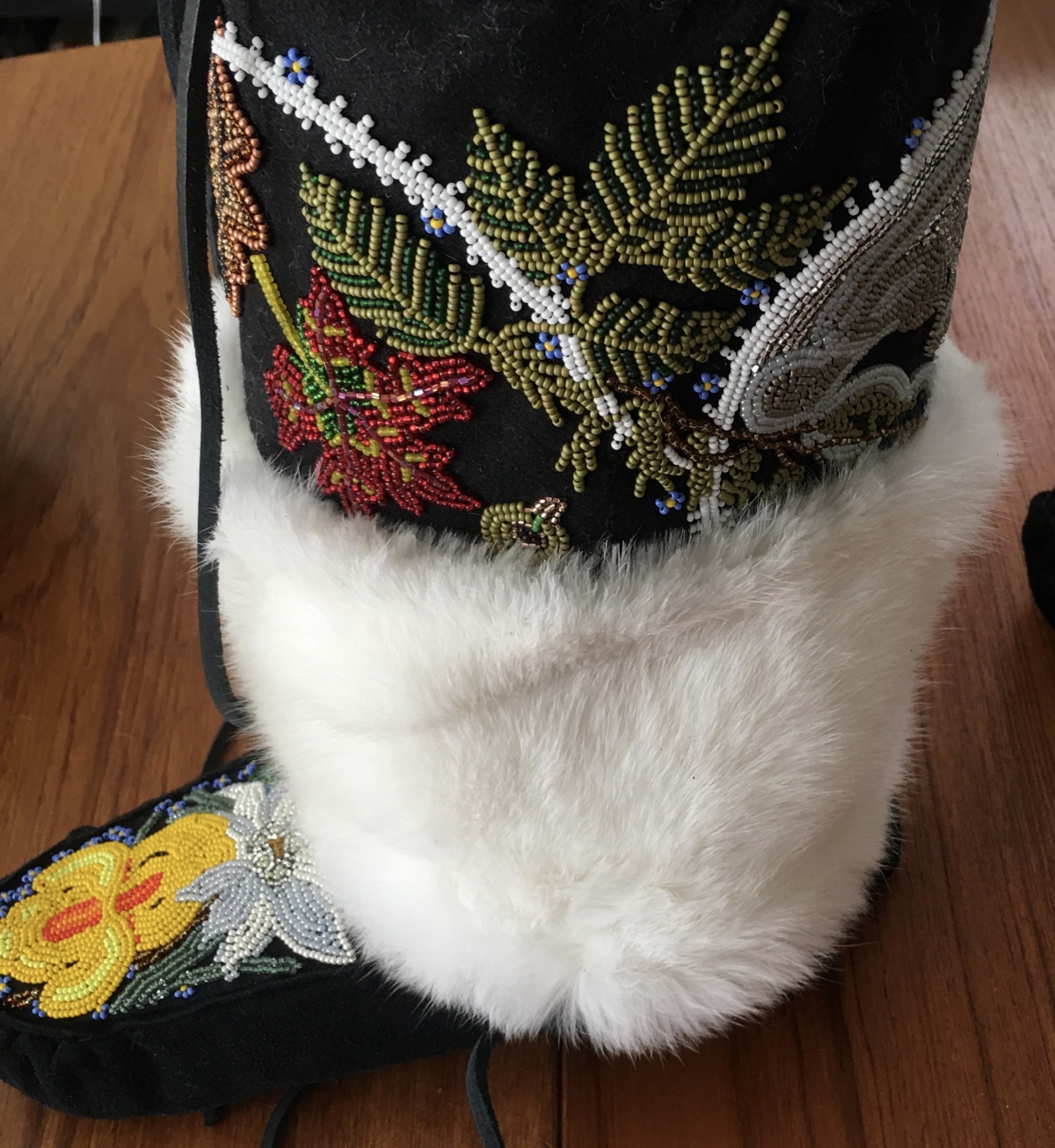
The trees on the mukluks are oak, elm, cedar, and maple, with beaded leaves and seeds.
"The trees are oak, elm, cedar, and maple, with beaded leaves and seeds. There are also floral buds, leaves, and seeds of the Scottish thistle, fleur-de-lis, the Manitoba pink wild rose, and edelweiss, which related to my Ancestors' heritage origins: Scottish, French, Anishinaabe, and German," Pichette said.
Their imagery also includes the four sacred medicines: cedar, sage, tobacco, and sweetgrass, to honour her Indigenous ancestry.
"The images run along what I've read are sometimes called the Métis 'tracks,'" she said, adding that the white lines of beads on one mukluk start from Grandmother Moon and lead back to her, while the other mukluk has the white lines of beads starting from and to Turtle Island.
"The forget-me-nots are one of my favourite flowers and are basically self-explanatory: they were spread throughout the work to not forget anybody along the way."
To create the plant imagery, Pichette looked for images of all of the plants she wanted to include, and then created drawings of each of them.
"I resized them on my printer to fit the spaces I wanted to put them in. The fleur-de-lis was the hardest element because I wanted to keep it non-political and primarily botanical, so I had to research the origins of the use of the fleur-de-lis and decided upon the yellow iris as the representation of the French ancestry fleur-de-lis," she said.
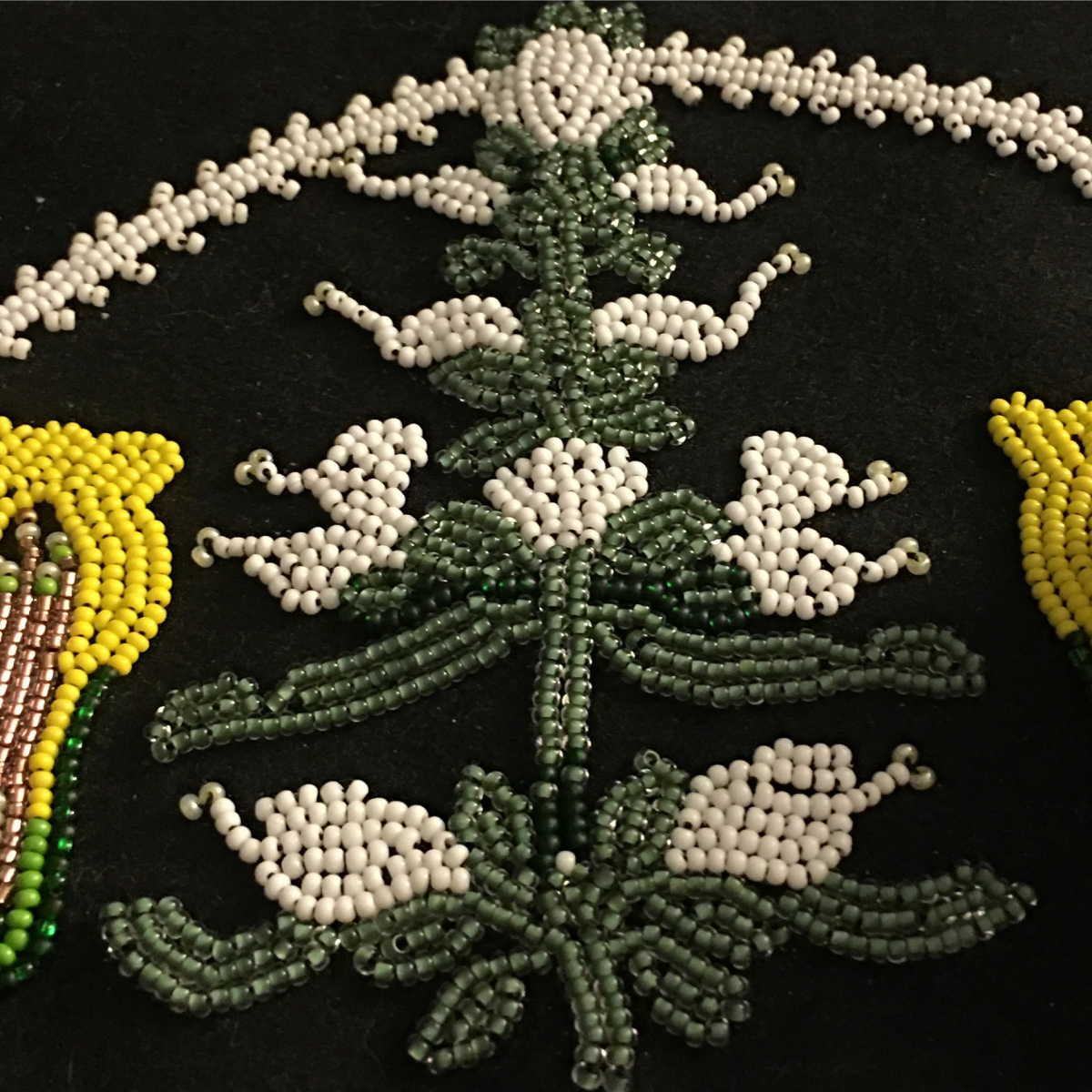
The mukluks' imagery also includes the four sacred medicines: cedar, sage, tobacco, and sweetgrass.
Ancestral connection
Pichette's inspiration to make the pair of mukluks came after a long journey to discover her Métis heritage.
"This is a more recent connection. And I say that with regret and a sense of loss - loss in time in that I wish I had known all about it many years ago," she said, adding that she is happy and grateful to have finally discovered and verified her ancestry, and for it to happen during her lifetime so she can proudly share it with her grandson.
"I had always known that I had paternal 'Indian' (ancestry), but knew absolutely nothing about it. My parents separated when I was very young. My paternal grandmother never spoke of it and my father only mentioned it maybe three times in my life that I remember, and very little was said. And they both died very early in my life," Pichette said.
Five years ago, at a dinner with friends, a bottle of Bousquet wine caught Pichette's eye. Bousquet was her dad's grandfather's last name, and Pichette decided to Google the last name to see what she could find.
"That sent me down a rabbit hole, because I was finding the name come up in other sources for other areas in connection to the Métis, and it just put things in motion to try and actually find out about my ancestry, because we really, we knew nothing. Aside from my dad and my grandma, we had no cousins, and no other relatives that we were aware of. So, it started quite the journey," she said.
While the winery ended up not being related, Pichette found ancestral information that surprised her, and traced one line of her paternal Ancestors back to the early 1700s. Years later, when COVID hit, many international archives opened up online with free access, which propelled her research.
"I discovered information about my Ancestors that involved endurance, strength, loss and sorrow, stubbornness but definitely great resilience, probably adventurous/curiosity-driven exploits and, like many families, there's skeletons in the closet," Pichette said. "What resounded with me was that this had been basically 'hushed history.'"
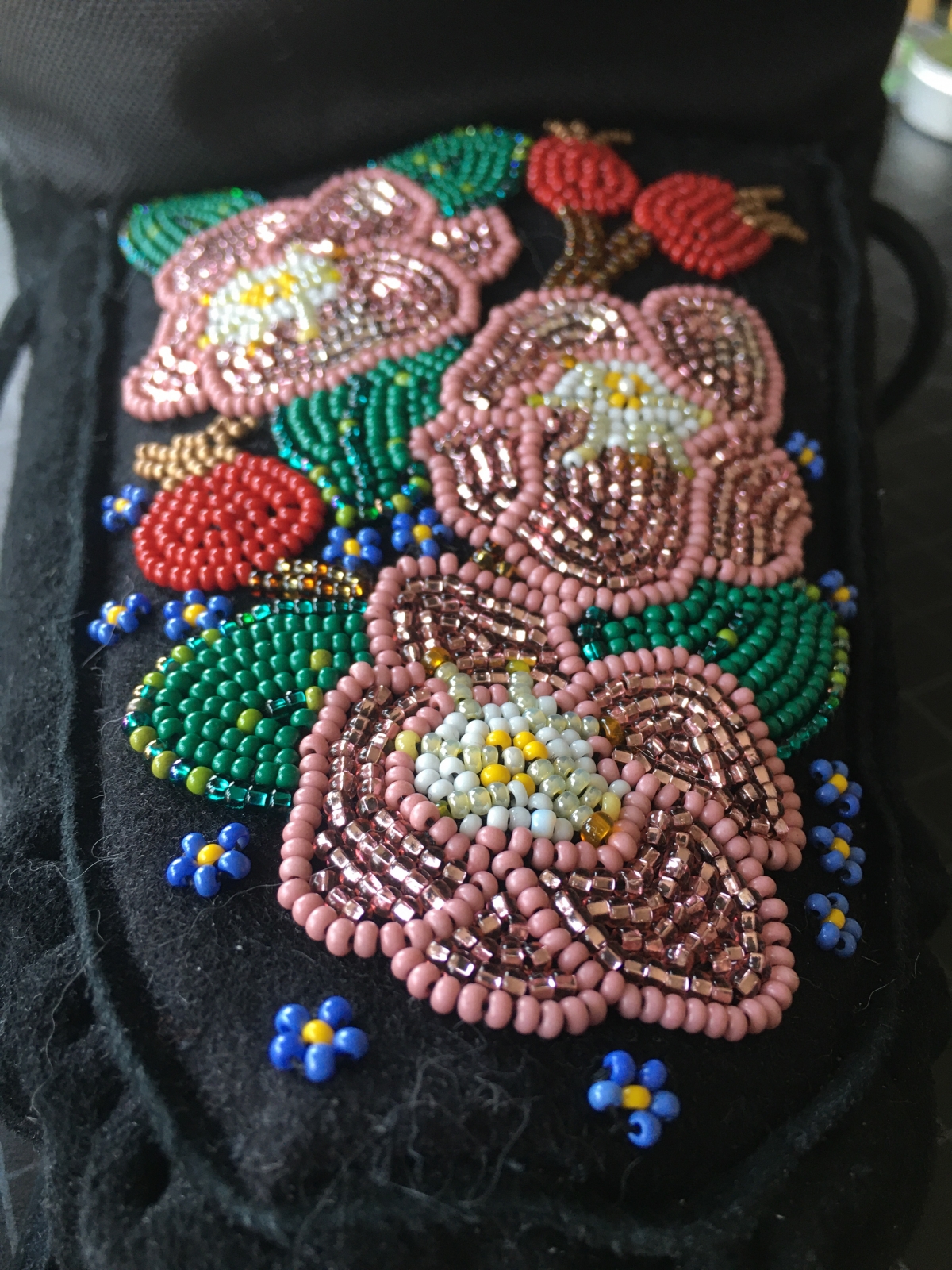
Botanical imagery on the mukluks include floral buds, leaves, and seeds of the Scottish thistle, fleur-de-lis, the Manitoba pink wild rose, edelweiss, and forget-me-nots.
This relates to Pichette's Ancestors' heritage origins: Scottish, French, Anishinaabe, and German.
Once she had her heritage verified through genealogy and other genealogical sources, she felt it was time to embrace her heritage and join the community.
"Learning how resilient and adaptable my Ancestors were really drew me in to feel close to them. It was like I felt them near, and hundreds of years of history were just like yesterday, like they were alive," she said. "I also had a very vivid dream about my grandmother, and that's what propelled me to (want) to know more about the Indigenous women who had basically walked the path leading to me."
Pichette said finding out about her heritage helped her feel more grounded. "It has helped me to understand my grandmother and father better, and that their silences and at times seeming distant was not indifference but more likely a learned behaviour of survival and self-protection of their lived experiences."
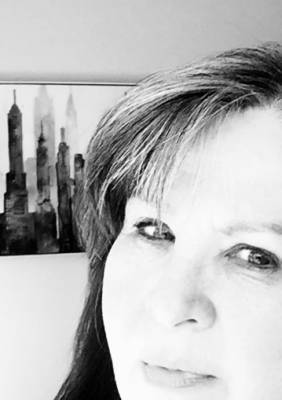
Michelle Pichette
Connection through beadwork
"I had always admired practical and creative works made by the Indigenous communities, and when I found I had a much closer connection to them than I had imagined, I immediately embraced specific types of work and wanted to learn as much as I could about it. The creative work made by the Métis made me feel that maybe that is where I got my creative abilities from that came so naturally to me, because I've always been able to make things with ease," she said, adding that she believes we have genetic memory that goes far beyond physical attributes.
Learning about her Ancestors drew Pichette to try her hand at beadwork specifically.
"One cannot do research on the Métis without encountering the masterful beadwork. The beauty they saw in all that was around them and how they created works of beauty to surround themselves with, to clothe their loved ones, enabling them to take a piece of home, made with love wherever they went, or to give as gifts, resonated strongly with me," she said.
Pichette's connection to her Métis heritage helped reconnect her with art.
"I have always loved colour and the outdoors, but more recently I found myself in a kind of a dark period of little work. And how this connection has informed my work is it's helped me to re-engage with the love of colour and to start bringing nature back into my work, which is something I hadn't done for quite some time," she said. "Seeing the precision, patience, care, and thoughtfulness that went into their work inspired me to want to learn how to bead properly."
Asked if she would make another pair, Pichette said she would love to - she has even had friends ask her to make them a pair of mukluks, but the material costs are very high. She said if she ever made a pair for herself or others, she would use traditionally tanned hides, preferably from someone in the Métis Community, to ensure the hides are ethically harvested.
Pichette is still researching and learning more about her family history. She hopes to share some of her history in an installation work at some point, and is giving thought to how best to do that.
"I think that there's stories that need to be told," Pichette said.
"I want to do my best to celebrate all the joy the Métis people created around themselves in both music and art, for they worked very hard and sacrificed much," she said, "to celebrate their resilience, endurance, strength, adaptability, and finding beauty where sometimes that would have been very difficult."
